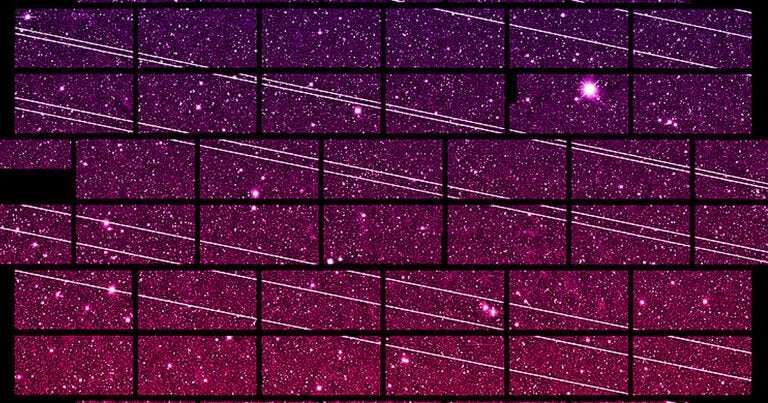Amazon was approved by the Federal Communications Commission to launch 3,326 satellites as part of its planned Kuiper constellation. That’s roughly 600 more satellites than the total number currently in orbit, as The New York Times reports. But who’s counting?
Astronomers are. And they’re worried. The news comes just a week after SpaceX launched its latest batch of 57 Starlink satellites, bringing the total number up to just shy of 600 already in orbit.
The reflective micro satellites have been photobombing astronomical observations of the night sky ever since they started being launched by SpaceX, appearing as bright streaks of light.
“We don’t yet have any kind of industrywide guidelines,” Michele Bannister, planetary astronomer at the University of Canterbury in New Zealand, told the Times.
“We don’t have an industry body that’s producing good corporate citizenship on the part of all of these enthusiastic companies that want to launch, and we don’t have any regulatory setup in place that’s providing clear guidelines back to the industry,” Bannister added. “To me, honestly, it feels like putting a bunch of planes up and then not having air traffic control.”
Problems are likely to persist as companies like SpaceX and Amazon continue to litter the night sky with thousands, if not tens of thousands, of their satellites.
While SpaceX has tried non-reflective coating and a sunshade to stop reflecting light, a fully effective solution has yet to be demonstrated. An Amazon spokesperson also told the Times that “reflectivity is a key consideration in our design and development process.”
Astronomers, however, are calling for national regulators to step up to the plate and make sure ground-based astronomy can survive this new trend. Whether or not they will — much like a potential clear night sky in the future — remains to be seen.
READ MORE: Amazon Satellites Add to Astronomers’ Worries About the Night Sky [The New York Times]
More on Starlink: SpaceX’s Starlink Satellites Ruined This Photo of the NEOWISE Comet

J0n__Snow on August 11st, 2020 at 10:57 UTC »
No, it needs an international regulation. Otherwise such companies just found another new company somewhere in the world and keep doing this shit.
riodoro1 on August 11st, 2020 at 09:46 UTC »
Fist we created light pollution and now this.
Scary thought that the night sky might not be available to the future generations or it might just be filled with advertisments.
Also, aren't we forgetting about Kessler sndrome?
Decronym on August 11st, 2020 at 09:43 UTC »
Acronyms, initialisms, abbreviations, contractions, and other phrases which expand to something larger, that I've seen in this thread:
Fewer Letters More Letters ASAT Anti-Satellite weapon ASDS Autonomous Spaceport Drone Ship (landing platform) BFR Big Falcon Rocket (2018 rebiggened edition) Yes, the F stands for something else; no, you're not the first to notice CNSA Chinese National Space Administration COTS Commercial Orbital Transportation Services contract Commercial/Off The Shelf CST (Boeing) Crew Space Transportation capsules Central Standard Time (UTC-6) CoM Center of Mass DMLS Selective Laser Melting additive manufacture, also Direct Metal Laser Sintering DSG NASA Deep Space Gateway, proposed for lunar orbit DST NASA Deep Space Transport operating from the proposed DSG DoD US Department of Defense E2E Earth-to-Earth (suborbital flight) ELT Extremely Large Telescope, under construction in Chile EOL End Of Life ERP Effective Radiated Power ESA European Space Agency FAA Federal Aviation Administration FCC Federal Communications Commission (Iron/steel) Face-Centered Cubic crystalline structure GEO Geostationary Earth Orbit (35786km) GSO Geosynchronous Orbit (any Earth orbit with a 24-hour period) Guang Sheng Optical telescopes HEO High Earth Orbit (above 35780km) Highly Elliptical Orbit Human Exploration and Operations (see HEOMD) HEOMD Human Exploration and Operations Mission Directorate, NASA HST Hubble Space Telescope INS Inertial Navigation System ITU International Telecommunications Union, responsible for coordinating radio spectrum usage Isp Specific impulse (as explained by Scott Manley on YouTube) Internet Service Provider JWST James Webb infra-red Space Telescope KSP Kerbal Space Program, the rocketry simulator L1 Lagrange Point 1 of a two-body system, between the bodies L2 Lagrange Point 2 (Sixty Symbols video explanation) Paywalled section of the NasaSpaceFlight forum LEO Low Earth Orbit (180-2000km) Law Enforcement Officer (most often mentioned during transport operations) MEO Medium Earth Orbit (2000-35780km) NDA Non-Disclosure Agreement NEO Near-Earth Object NORAD North American Aerospace Defense command NSF NasaSpaceFlight forum National Science Foundation QA Quality Assurance/Assessment Roomba Remotely-Operated Orientation and Mass Balance Adjuster, used to hold down a stage on the ASDS Roscosmos State Corporation for Space Activities, Russia SLS Space Launch System heavy-lift Selective Laser Sintering, contrast DMLS TDRSS (US) Tracking and Data Relay Satellite System TLE Two-Line Element dataset issued by NORAD ULA United Launch Alliance (Lockheed/Boeing joint venture) USAF United States Air Force VLBI Very-Long-Baseline Interferometry Jargon Definition Sabatier Reaction between hydrogen and carbon dioxide at high temperature and pressure, with nickel as catalyst, yielding methane and water Starliner Boeing commercial crew capsule CST-100 Starlink SpaceX's world-wide satellite broadband constellation apoapsis Highest point in an elliptical orbit (when the orbiter is slowest) apogee Highest point in an elliptical orbit around Earth (when the orbiter is slowest) periapsis Lowest point in an elliptical orbit (when the orbiter is fastest) perigee Lowest point in an elliptical orbit around the Earth (when the orbiter is fastest)[Thread #5048 for this sub, first seen 11th Aug 2020, 09:40] [FAQ] [Full list] [Contact] [Source code]